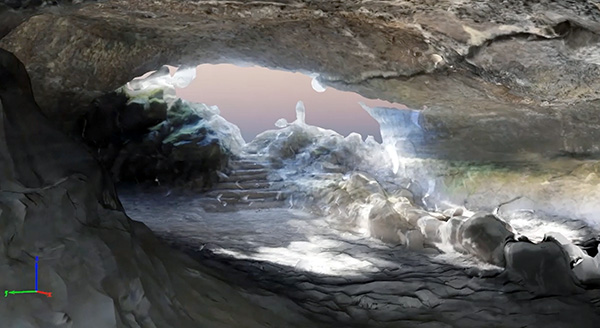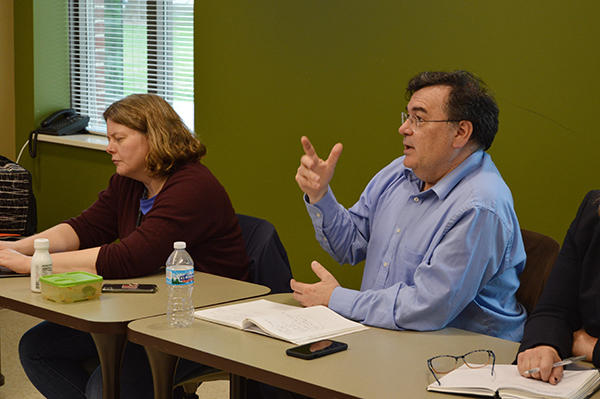NASA selects Purdue to develop resilient and smart deep space habitats
Purdue Civil Engineering to lead $15M effort to establish humans on the moon and Mars
The launchpad for humanity's next giant leap will very likely start at Purdue University.
Since well before Neil Armstrong ever made his — and humanity's — first step on the moon, a dream for many (and the basis for countless works of science fiction) has been to establish permanent settlements in space. And now, led by a research team from the Lyles School of Civil Engineering, humanity is getting closer to making that dream a reality.
In the spring of 2019, NASA selected Purdue Resilient ExtraTerrestrial Habitats Institute (RETHi) as one of its two multidisciplinary, university-led research Space Technology Research Institutes charged with the task of developing technologies critical to establishing a sustainable human presence on the moon and Mars. The grant is for $15 million over a five-year period.
The RETH Institute team will conduct research needed to develop resilient deep space habitats that can adapt, absorb and rapidly recover from expected and unexpected disruptions. RETHi will leverage Purdue's world-class expertise in developing civil infrastructure responsive to catastrophic natural hazards and merge it with leaders in the fields of autonomous robotics, smart buildings, hybrid simulation, transformable architecture, and diagnostics and prognostics for intelligent health management.

One of the most likely options for establishing civilizations on either Mars or the moon, Purdue researchers said, is be utilizing underground lava tubes. The benefits to using lava tubes is that it would shield inhabitants from temperature variation, meteorite impacts, and radiation.
The project is led by principal investigator Shirley J. Dyke, professor of civil engineering and mechanical engineering, and she is joined, within civil engineering, by Prof. Antonio Bobet, Prof. Mohammad Jahanshahi, and Prof. Julio Ramirez. The multidisciplinary partnership includes additional researchers from Purdue University, the University of Connecticut, Harvard University and the University of Texas at San Antonio.
"Partnering with universities lets us tap into new expertise, foster innovative ideas, as well as expand the research and development talent base for both aerospace and broader applications," said Jim Reuter, acting associate administrator of NASA's Space Technology Mission Directorate. "We're excited to work with these two new STRIs to develop smart habitat technologies for exploration missions on the moon and Mars."
Dyke said the team's research over the next five years has three thrusts: building resilience into these SmartHabs, using sensors and data to monitor and manage the health of the habitat, and providing robots with the ability to handle automated repair and maintenance.
"Our focus is on developing smart deep space habitats that are self-aware," Dyke said. "The idea is to establish the knowhow to build smart habitats that have the ability to monitor what's happening, respond, and take corrective actions — whether that is through humans, robots, or automation."
Currently, Dyke said, the team is working on creating that cyber-physical test bed — a combination of mechanical and computational elements that can be used for system-level studies — for experimentation on how intelligence can be integrated into complex systems, assessing the expected environmental challenges they will face in the creation and maintenance of a settlement, and establishing a system that can respond swiftly and accurately to issues when they arise.
Julio Ramirez, the Karl H. Kettelhut Professor in Civil Engineering, said this is an exciting time to be a civil engineer.
"This project is what civil engineering is all about," Ramirez said. "It's about setting new horizons and pushing the boundaries as humanity progresses forward by providing shelter and an environment to achieve its best. This is all deeply rooted in Purdue's space related tradition as home to so many astronauts, like Neil Armstrong, and to train the next generation of leaders in the field."
Mohammad Jahanshahi, assistant professor of civil engineering with courtesy appointment to the school of electrical and computer engineering, said this project provides a unique opportunity for educating the next generation of civil engineers who will be collaborating in an interdisciplinary manner with engineers from other disciplines to tackle challenging problems of the future.
"In addition, the lessons learned throughout this project will be used to further enhance the resilience of our civil infrastructure here on earth," Jahanshahi said.
"This is a great opportunity for our students as well as for the civil engineering community at large," Edgar B. and Hedwig M. Olson Professor in Civil Engineering Antonio Bobet said. "We will use the expertise that we have accumulated here on Earth by addressing all the past challenges and hazards, to learn and tackle the enormous difficulties that a permanent habitat faces in space and, most importantly, to educate the civil engineers of the future: those who will build the infrastructure that will make it possible for humanity to thrive on the Moon and Mars and beyond."
Much of the research done will be conducted at the Robert L. and Terry L. Bowen Laboratory for Large-Scale Civil Engineering Research and the Ray W. Herrick Laboratories, where the RETH Institute team plans to build scaled cyber-physical experiments to demonstrate the technologies.
"The idea is with such a unique test bed we can swap subsystems in and out to examine different aspects of the habitat system and their interactions," Dyke said. "To succeed we must draw on the tangible experience gained over centuries on Earth to build resilience in terrestrial communities."

In addition to researching to establish civilizations on other planets, the RETH Institute professors also teach a new class called "Life on Mars" where students researched the challenges facing future Mars settlers and developed plans on how to combat them.

About the foundation of the Resilient ExtraTerrestrial Habitats Institute
The NASA-funded RETH Institute also includes participating universities the University of Connecticut, Harvard University, and the University of Texas San Antonio. RETHi leadership includes: Shirley Dyke (PU, Principal Investigator), Karen Marais (PU) (Lead, Thrust 1), James Braun (PU) (Lead, Thrust 2), Justin Werfel (HU) (Lead, Thrust 3), and Ramesh Malla (UC) (Lead, Industrial Collaboration). Multidisciplinary team members are: Ilias Bilionis (PU), Antonio Bobet (PU), David Cappelleri (PU), George Chiu (PU), Ashwin Dani (UC), Elena Glassman (HU), Song Han (UC), Chuck Hoberman (HU), Mohammad Jahanshahi (PU), Arturo Montoya (UTSA), Krishna Pattipati (UC), Julio Ramirez (PU), Jiong Tang (UC), Dawn Whitaker (PU), and Rob Wood (HU). Industrial partners include: UTC Collins Aerospace and ILC Dover.
Purdue's RETH project initiated in 2017 through a New Horizons grant awarded by the University's Office of the Provost. New Horizons is a competitive program challenging established senior faculty to create new academic areas for the coming decades. Team members included Antonio Bobet, professor of civil engineering; Shirley J. Dyke, professor of civil engineering and mechanical engineering; Julio Ramirez, the Karl H. Kettelhut professor in civil engineering; and Jay Melosh, distinguished professor of earth and atmospheric sciences and physics.
In addition to conducting research on how to establish viable and resilient settlements beyond the surface of the earth, the team also developed a new honors class called "Life on Mars," where students researched the many challenges facing future Mars settlers and discussed and debated approaches on how to combat them.
